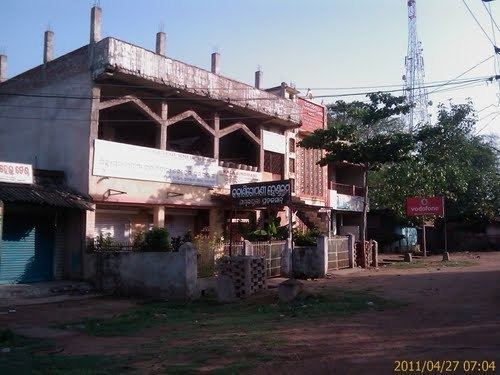District Bargarh Time zone IST (UTC+5:30) Local time Thursday 12:03 PM | Elevation 182 m (597 ft) Vehicle registration OD | |
 | ||
Weather 34°C, Wind S at 10 km/h, 21% Humidity | ||
Barpali (odia:ବରପାଲି); a small town, a Notified Area Council (NAC) and a block (Tehsil) within the Bargarh district in the state of Odisha, India. This town has its own significance in the state of Odisha and its culture and arts with respect to the great Odia Poet Gangadhar Meher, who was born here in 1862 AD. Known for his tremendous contribution to the Odia literature in the form of numerous magnificent poetic-collections (Kavyavali) mostly through his unique touch of devotional, mythological and vastly nature-connecting narratives. Some of his great Poetry works were : Tapaswini, Pranaya-Ballari, Kichaka-Vadha, Indumati, Rasa-Ratnakara, Balaram-Dev, Ayodhya Drusya, Padmini etc., which have been critically acclaimed by literature scholars across the globe. Aptly, he was known as the 'Swabhaba Kavi' of the Odia literature amongst his contemporaries.
Contents
- Map of Barapali Town Odisha 768029
- Location
- Demographics
- Indigenous art and craft
- Religious culture
- Educational institutions
- Other significance
- References
Map of Barapali Town, Odisha 768029
Location
The geo-coordinates for Barpali is 21.1813° N, 83.5976° E, which is situated at a height of 182 m (597 ft) from sea level. Conveniently connected through railway network (Train Station name: BARPALI, IRCTC Train Station Code: BRPL) and via road (via NH-26); the urban area of Barpali is situated at a distance of 21 km by road from the Bargarh district and 19 km by train. The communication to Barpali has improved radically over the past few decades as it can be easily reachable now from the state capital Bhubaneswar within hours - besides from all the neighbouring state-capitals and other major Indian cities via railway networks (Raipur- Chhattisgarh), (Kolkata-West Bengal) (Chennai-Tamil Nadu) etc. amongst others. The nearest International airport is at Bhubaneswar (425 km away) and domestic airports (Raipur, Ranchi) are at approximate distances of 225 and 450 km from Barpali.
Demographics
As of 2001 India census, Barapali had a population of 19,154; whereas the 2011 national census shows the population growing to 128,271. Males constitute approximately 51% of the population and females 49%. Barpali has an average literacy rate of 68.5%, higher than the national literacy average; with 59% of the males and 41% of females literate. The majority of the population is engaged in household industries, agriculture or government/private service. Around 11% of the total population is under 6 years of age. The nearby settlements of Barpali include Gopaipali, Badgaon, Kainshir, Dhirpur, Remta, Kumbhari Barangpali, Satalma, and Kadalipali, Lenda, etc. The electoral jurisdiction of Barpali comes under the Bijepur constituency of Odisha state Assembly and the parliamentary (central) electoral jurisdiction is under the Bargarh lok sabha constituency. Notably, the Barpali Block consists of 23 Panchayats which have in total 57 villages.
Indigenous art and craft
Barpali town has been the birthplace for many handloom workers. Some of them are masters in 'IKAT' (an indigenous and unique technique of dyeing fabric and then hand-weaving of the famous Sambalpuri clothes used for making sarees and other apparels). The other famous handicraft from this place is the 'TERRAKOTTA and POTTERY' works. Many of those Barpali artists of Ikat, Saree weavers, designers and Terrakotta have brought laurels to this land including national awards and international recognition on multiple occasions and across various platforms.
Religious culture
Educational institutions
Barpali has been home to several notable personalities who received their primary education here. These schools are among many others which are either Regional (Odia) or English/Hindi-medium based secondary schools etc. supported by Government of India Dept. of Education or Private societies or charitable trusts and committees.
Apart from a numbers of primary schools in the town, some notable schools are listed below including a rare few, whose establishments date back to more than a century:
Barpali town is also native to some of the renowned Government high schools as:
There are undergraduate and post-graduate institutions are also located in the town itself, e.g.
Other significance
From time immemorial (mostly believed during the transition of pre to post independent era in India), the older version of the household sanitary Indian-style toilets (colloquially known as Barapali-Toilets) started being made and used here by some overseas Doctors, Researchers and locally trained volunteers. The usage of these toilets then got widespread within the town and subsequently to other places, mostly in the adjoining villages - this has been considered as a pivotal step in beginning of the health hygiene and sanitation in Indian villages even in those old times.
